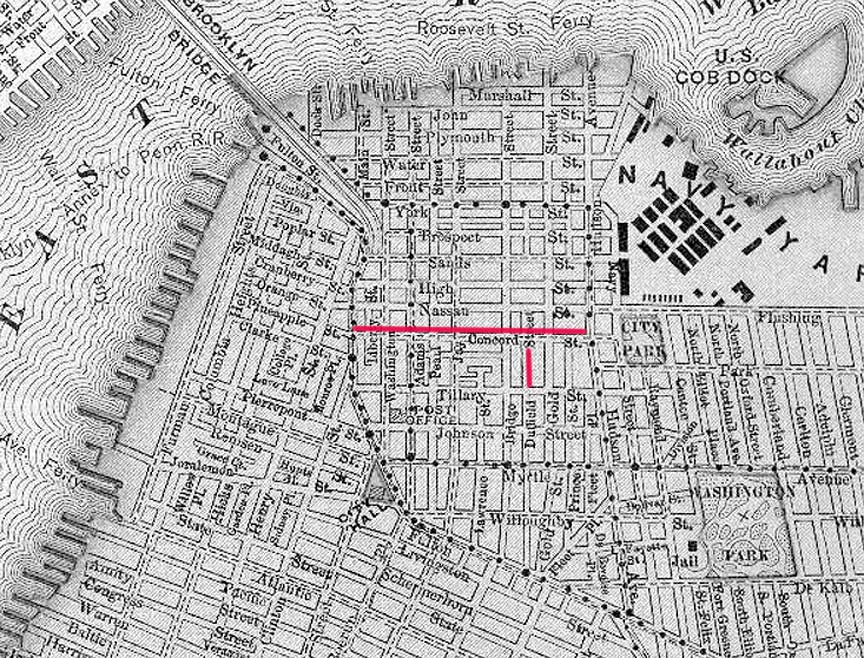 Concord Street is one of those east-west Brooklyn streets that can’t be neatly fitted into a neighborhood. It’s too far east to be in Brooklyn Heights, too far south to be in DUMBO, too far west to be in Fort Greene, and too far north, really, to be part of Downtown the way, say, Fulton and Livingston Streets are. For the first century or so of its existence, it didn’t need to belong to a neighborhood; it was just a part of Brooklyn Village and later, a part of the City of Brooklyn. All this changed in 1898 when Brooklyn narrowly voted to become the Borough of Brooklyn in Greater New York.
After that agglomeration happened, development commenced apace. The above map shows the full extent of Concord Street in 1895, when it ran from Fulton (now called Cadman Plaza West) and Pineapple streets east in a straight line to Navy Street, named for the Brooklyn Navy Yard. East-west streets here are named for local luminaries (physician James Tillary, entrepreneur Samuel Willoughby) steamboats (Robert Fulton’s Nassau) topography (High Street, Prospect Street). Concord Street is named for the Massachusetts town where, along with Lexington, the first battles of the Revolutionary War were fought on April 19, 1775. While Lexington is commemorated by lengthy avenues in Manhattan and Brooklyn, Concord has to settle for a short stretch here.
And the stretch is shorter than it’s ever been. Beginning in the 1940s, Concord Street was cut back in stages beginning with the construction of Parkes Cadman Plaza, which gave a welcome swath of green to the dense downtown area (in late 40s and 50s tradition, it’s largely boring) and in the 1960s a grouping of stolid 15-story apartment buildings was constructed in place of the stretch between Adams and Jay Streets. Thus, since 1895 Concord Street has lost about half its total length.
As we’ll see here, Concord and a short stretch of Duffield (marked in red on the map) represent a diminutive oasis of residential buildings representing Brooklyn the way it must have looked like in 1895, when all the surrounding streets were residential.
Concord Street is one of those east-west Brooklyn streets that can’t be neatly fitted into a neighborhood. It’s too far east to be in Brooklyn Heights, too far south to be in DUMBO, too far west to be in Fort Greene, and too far north, really, to be part of Downtown the way, say, Fulton and Livingston Streets are. For the first century or so of its existence, it didn’t need to belong to a neighborhood; it was just a part of Brooklyn Village and later, a part of the City of Brooklyn. All this changed in 1898 when Brooklyn narrowly voted to become the Borough of Brooklyn in Greater New York.
After that agglomeration happened, development commenced apace. The above map shows the full extent of Concord Street in 1895, when it ran from Fulton (now called Cadman Plaza West) and Pineapple streets east in a straight line to Navy Street, named for the Brooklyn Navy Yard. East-west streets here are named for local luminaries (physician James Tillary, entrepreneur Samuel Willoughby) steamboats (Robert Fulton’s Nassau) topography (High Street, Prospect Street). Concord Street is named for the Massachusetts town where, along with Lexington, the first battles of the Revolutionary War were fought on April 19, 1775. While Lexington is commemorated by lengthy avenues in Manhattan and Brooklyn, Concord has to settle for a short stretch here.
And the stretch is shorter than it’s ever been. Beginning in the 1940s, Concord Street was cut back in stages beginning with the construction of Parkes Cadman Plaza, which gave a welcome swath of green to the dense downtown area (in late 40s and 50s tradition, it’s largely boring) and in the 1960s a grouping of stolid 15-story apartment buildings was constructed in place of the stretch between Adams and Jay Streets. Thus, since 1895 Concord Street has lost about half its total length.
As we’ll see here, Concord and a short stretch of Duffield (marked in red on the map) represent a diminutive oasis of residential buildings representing Brooklyn the way it must have looked like in 1895, when all the surrounding streets were residential.
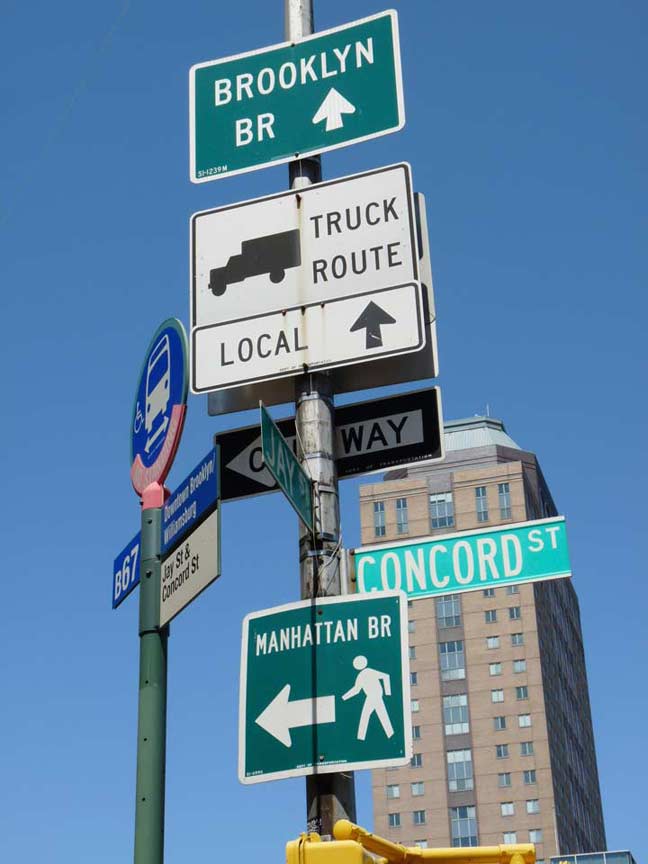 A light post at Jay and Concord Streets has agglomerated a number of traffic signs over the years. Jay Street is used by trucks approaching the Brooklyn-Queens Expressway and Manhattan Bridges, but not the Brooklyn, where clearances are low.
A light post at Jay and Concord Streets has agglomerated a number of traffic signs over the years. Jay Street is used by trucks approaching the Brooklyn-Queens Expressway and Manhattan Bridges, but not the Brooklyn, where clearances are low.
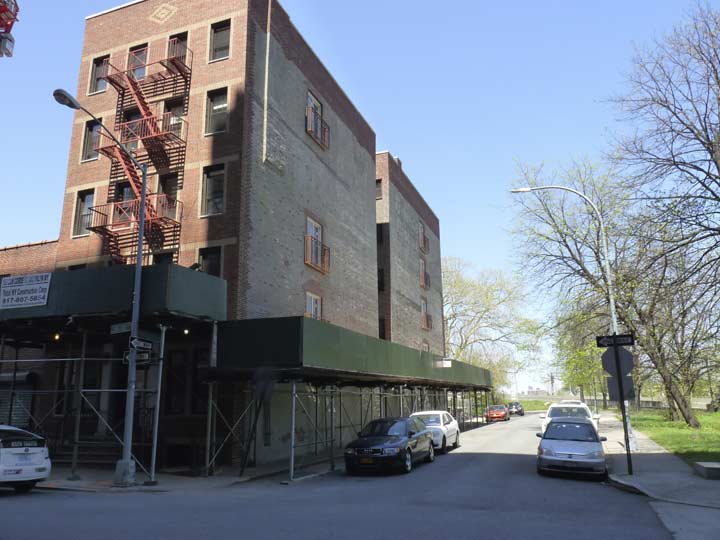 Concord Street comes to a temporary end at the Flatbush Avenue Extension, which was built in 1909 to connects Brooklyn’s signature avenue (which had formerly run from Fulton Street) to the Manhattan Bridge. At one time I think traffic could indeed proceed with traffic lights through the FAE, but that was changed a few decades ago and now eastbound Concord Street traffic is shunted to Nassau Street via Bridge Plaza Street, shown here, which has never made any of the commercial printed maps.
Concord Street comes to a temporary end at the Flatbush Avenue Extension, which was built in 1909 to connects Brooklyn’s signature avenue (which had formerly run from Fulton Street) to the Manhattan Bridge. At one time I think traffic could indeed proceed with traffic lights through the FAE, but that was changed a few decades ago and now eastbound Concord Street traffic is shunted to Nassau Street via Bridge Plaza Street, shown here, which has never made any of the commercial printed maps.
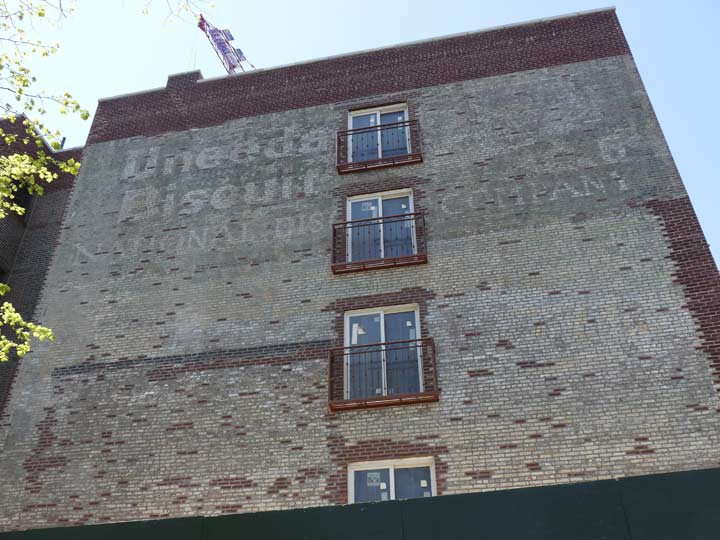 Yet, Bridge Plaza Street has its own century-old artifact, as this painted ad for Uneeda Biscuit was placed high above the former rooflines that once stood next to this relatively tall apartment house. The National Biscuit Company (yes, NBC long before the National Broadcasting Company) distributed Uneeda brand from about 1900 through 2008.
A huge factory that formerly turned out threads for the Howard Clothes Company (a men’s haberdasher), and before that, gyroscopes, stands on the west side of the pedal to the metal Flatbush Avenue Extension between Concord and Chapel Streets is now a residential tower called The Howard. The superstructure for a huge neon sign that displayed the Howard Clothes name for Manhattan-bound traffic is still there; I remember riding in a car up the FAE and seeing only the H and W remaining. The company was founded in 1924 by founded by Samuel Kappel, Joseph Langerman, and Henry Marks and named after Langerman’s son Howard. Info on Howard Clothes has been somewhat sketchy (not even a wikipedia listing) but luckily, Consumer Grouch has a great page complete with newspaper ads. Howard Clothes remained in business until 1970; it competed with Bond and Eagle Clothes much of its existence and all three has massive neon billboards somewhere in NYC that are now all gone.
Interestingly, Howard Clothes founder Samuel Kappel had acromegaly, a disease of the pituitary gland that causes distorted facial features like those of 1930s-40s actor Rondo Hatton. The disease is treatable in the modern era.
The building was constructed between 1915 and 1916, architect Frank J. Helmle and was originally a gyroscope factory built by inventor, engineer and industrialist Elmer Ambrose Sperry. With World War I on the horizon, America’s involvement seemed inevitable, and the gyroscope was a key air and sea navigation instrument. The company later developed the UNIVAC computer before being broken up with some divisions joining Honeywell and others Lockheed Martin.
Yet, Bridge Plaza Street has its own century-old artifact, as this painted ad for Uneeda Biscuit was placed high above the former rooflines that once stood next to this relatively tall apartment house. The National Biscuit Company (yes, NBC long before the National Broadcasting Company) distributed Uneeda brand from about 1900 through 2008.
A huge factory that formerly turned out threads for the Howard Clothes Company (a men’s haberdasher), and before that, gyroscopes, stands on the west side of the pedal to the metal Flatbush Avenue Extension between Concord and Chapel Streets is now a residential tower called The Howard. The superstructure for a huge neon sign that displayed the Howard Clothes name for Manhattan-bound traffic is still there; I remember riding in a car up the FAE and seeing only the H and W remaining. The company was founded in 1924 by founded by Samuel Kappel, Joseph Langerman, and Henry Marks and named after Langerman’s son Howard. Info on Howard Clothes has been somewhat sketchy (not even a wikipedia listing) but luckily, Consumer Grouch has a great page complete with newspaper ads. Howard Clothes remained in business until 1970; it competed with Bond and Eagle Clothes much of its existence and all three has massive neon billboards somewhere in NYC that are now all gone.
Interestingly, Howard Clothes founder Samuel Kappel had acromegaly, a disease of the pituitary gland that causes distorted facial features like those of 1930s-40s actor Rondo Hatton. The disease is treatable in the modern era.
The building was constructed between 1915 and 1916, architect Frank J. Helmle and was originally a gyroscope factory built by inventor, engineer and industrialist Elmer Ambrose Sperry. With World War I on the horizon, America’s involvement seemed inevitable, and the gyroscope was a key air and sea navigation instrument. The company later developed the UNIVAC computer before being broken up with some divisions joining Honeywell and others Lockheed Martin.
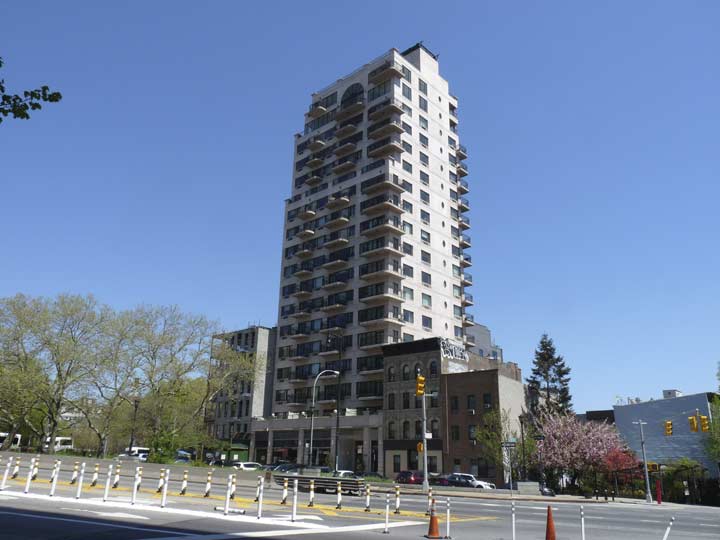 The FAE is now attracting numerous high-rise developments because of its proximity to bridge and Manhattan views. such as this balconied number at Bridge Street…
The FAE is now attracting numerous high-rise developments because of its proximity to bridge and Manhattan views. such as this balconied number at Bridge Street…
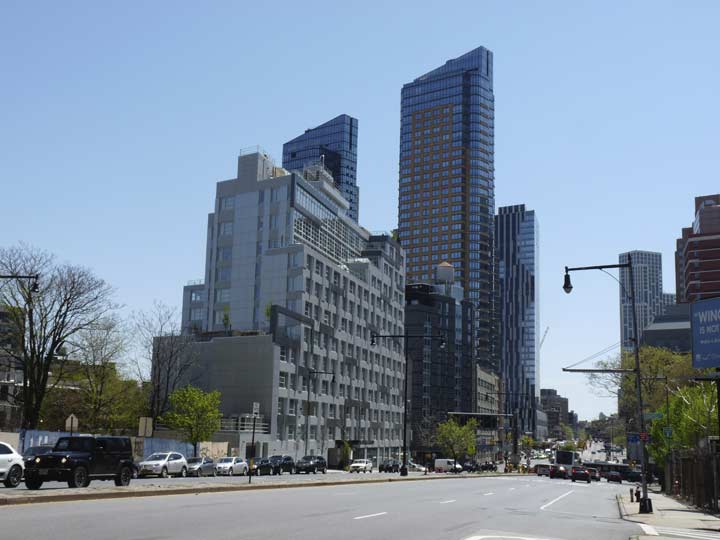 … as well as others such as Oro, so named because of its Gold Street location; now called “BKLYN Air” and behind it, Toren, on Myrtle Avenue with its unusually “riveting” facade.
Bridge Plaza Community Garden, Concord and Bridge Streets:
The garden was founded in 1995 as a part of the curriculum of P.S. 141K, an elementary school across the street. The garden contains vegetable beds which are assigned to various classrooms of the school and mature trees, simulated wet lands, brick paths lined by ornamental and herb gardens. It is used every year to teach science. The garden provides an important respite from the noise and fumes generated by the heavy traffic on the Manhattan Bridge. [ACGA]
… as well as others such as Oro, so named because of its Gold Street location; now called “BKLYN Air” and behind it, Toren, on Myrtle Avenue with its unusually “riveting” facade.
Bridge Plaza Community Garden, Concord and Bridge Streets:
The garden was founded in 1995 as a part of the curriculum of P.S. 141K, an elementary school across the street. The garden contains vegetable beds which are assigned to various classrooms of the school and mature trees, simulated wet lands, brick paths lined by ornamental and herb gardens. It is used every year to teach science. The garden provides an important respite from the noise and fumes generated by the heavy traffic on the Manhattan Bridge. [ACGA]
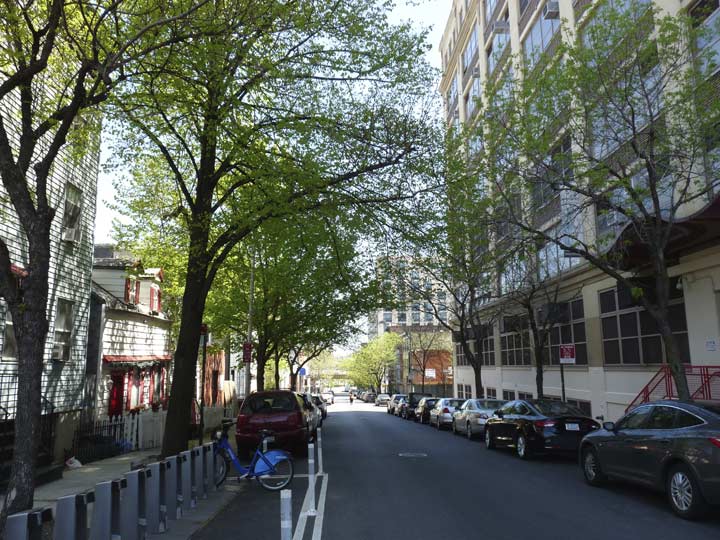 We now enter the small community of Bridge Plaza, a grouping of private brick, mortar and wood frame homes that have hung on from a much earlier time. As the immediately surrounding area became filled with warehouses, factories and housing projects — and may of its streets eliminated — most of these small buildings were wiped out. As I’ve said, originally the region didn’t have a name, but I’m told that the name Bridge Plaza was settled on. I remember a book about Brooklyn bike routes that came out in the mid-1990s had a different name for this area, but I got rid of it several years later and it seems to have vanished without a trace, with no mentions in amazon or wikipedia. I’d like to have the book back just to get the name!
We now enter the small community of Bridge Plaza, a grouping of private brick, mortar and wood frame homes that have hung on from a much earlier time. As the immediately surrounding area became filled with warehouses, factories and housing projects — and may of its streets eliminated — most of these small buildings were wiped out. As I’ve said, originally the region didn’t have a name, but I’m told that the name Bridge Plaza was settled on. I remember a book about Brooklyn bike routes that came out in the mid-1990s had a different name for this area, but I got rid of it several years later and it seems to have vanished without a trace, with no mentions in amazon or wikipedia. I’d like to have the book back just to get the name!
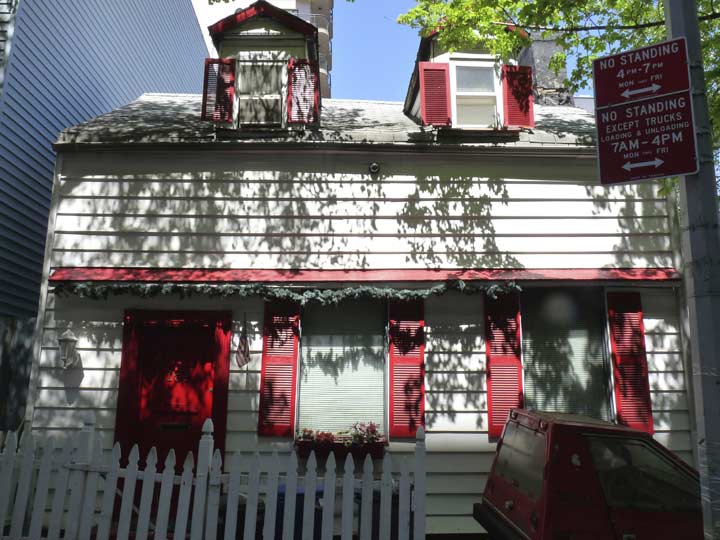 #167 Concord Street is a tiny, two-story frame dwelling with two dormers. The house is among the oldest in the neighborhood. According some sources it was built in 1762, while the land it is built on was deeded in 1674; the land was in Dutch hands until the 1770s, when English names began appearing on the records. It is surrounded by a stone wall dating to about 1820. The house is rumored to have participated in the Underground Railroad in the pre-Civil war era.
Parked outside is owner Frank Didik’s car, a hybrid gasoline/electric powered vehicle called the Didik Long Ranger designed in the mid-1980s. It’s 96 inches long, 65 inches wide and 56 inches high and can comfortably seat three people. It can travel about 70-100 miles per charge, but the gasoline engine can power it only to a top speed of 30 MPH. It also contains solar panels to assist in charging the batteries. Didik, who has owned 167 Concord since 1985, took an earlier Citicar, manufactured by Sebring-Vanguard, and modified it; he also designed the Didik Sun Shark, a solar-powered motorcycle, and the Didik Duplexity, a foldable scooter that rides three people.
Didik has, of course, removed the batteries.
Another pair of 19th Century homes at Concord and Duffield. Quite the contrast to the balconied behemoth on Bridge Street.
#167 Concord Street is a tiny, two-story frame dwelling with two dormers. The house is among the oldest in the neighborhood. According some sources it was built in 1762, while the land it is built on was deeded in 1674; the land was in Dutch hands until the 1770s, when English names began appearing on the records. It is surrounded by a stone wall dating to about 1820. The house is rumored to have participated in the Underground Railroad in the pre-Civil war era.
Parked outside is owner Frank Didik’s car, a hybrid gasoline/electric powered vehicle called the Didik Long Ranger designed in the mid-1980s. It’s 96 inches long, 65 inches wide and 56 inches high and can comfortably seat three people. It can travel about 70-100 miles per charge, but the gasoline engine can power it only to a top speed of 30 MPH. It also contains solar panels to assist in charging the batteries. Didik, who has owned 167 Concord since 1985, took an earlier Citicar, manufactured by Sebring-Vanguard, and modified it; he also designed the Didik Sun Shark, a solar-powered motorcycle, and the Didik Duplexity, a foldable scooter that rides three people.
Didik has, of course, removed the batteries.
Another pair of 19th Century homes at Concord and Duffield. Quite the contrast to the balconied behemoth on Bridge Street.
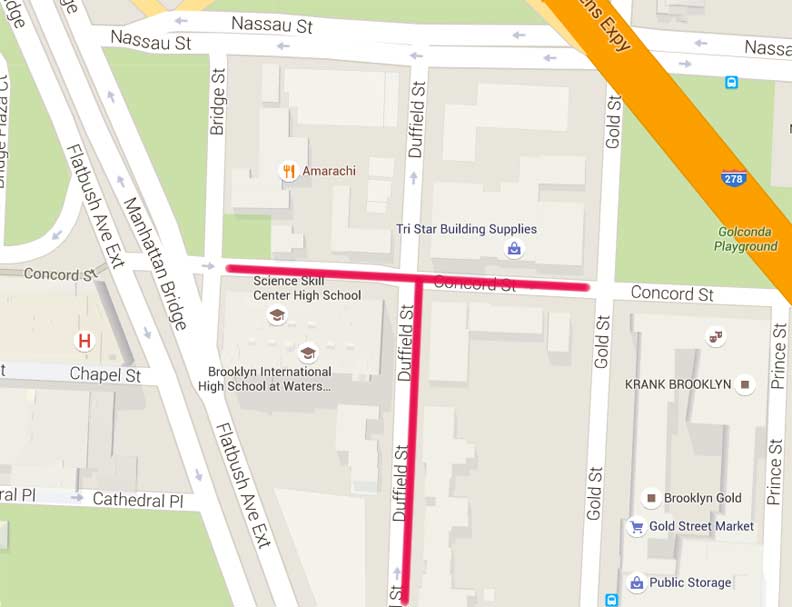 Modern-day Google map of the Bridge Plaza neighborhood. The older dwellings are concentrated on the north end of Concord between Bridge and Duffield and on both sides of Duffield south of Concord, and the south side of Concord between Duffield and Gold.
Modern-day Google map of the Bridge Plaza neighborhood. The older dwellings are concentrated on the north end of Concord between Bridge and Duffield and on both sides of Duffield south of Concord, and the south side of Concord between Duffield and Gold.
Duffield Street
Duffield Street is one of two streets in Brooklyn to end in -ffield. The other one is Sheffield Avenue in East New York. It was named for Revolution-era Brooklyn Village surgeon John Duffield; a long-vanished parallel street, Barbarin Street, was also named for a doctor. A group of buildings at 225, 231, 235, 223, 227 and 233 Duffield near Fulton Street are believed to date to the Civil War era and are further believed by their owners to be former homes of abolitionists, if not stops on the Underground Railroad, as was the nearby 1846 First Free Congregational Church, later the African Wesleyan Methodist Episcopal Church on Bridge Street south of Johnson Street in MetroTech Center. The block of Duffield running between Concord and Tillary Street retains a great deal of Bridge Plaza’s remaining private dwellings.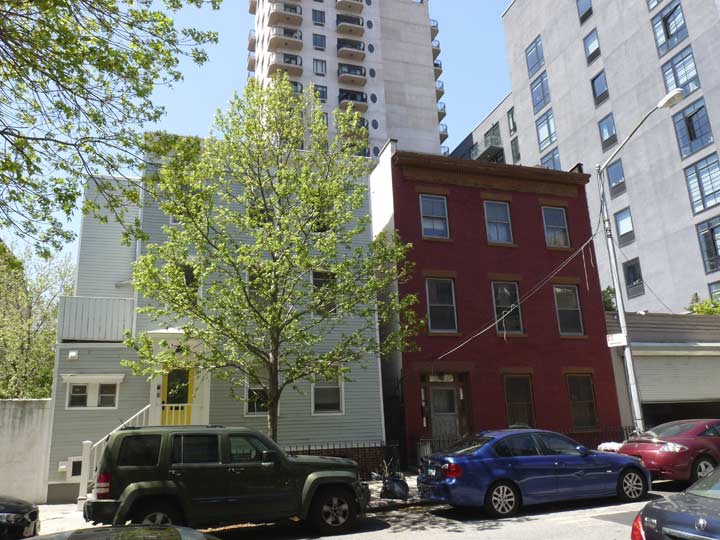 There are just a pair of older dwellings on Duffield north of Concord going toward Nassau Street.
#39 through #43 Duffield Street, brick multifamily buildings that can boast some of their original entrance railings.
There are just a pair of older dwellings on Duffield north of Concord going toward Nassau Street.
#39 through #43 Duffield Street, brick multifamily buildings that can boast some of their original entrance railings.
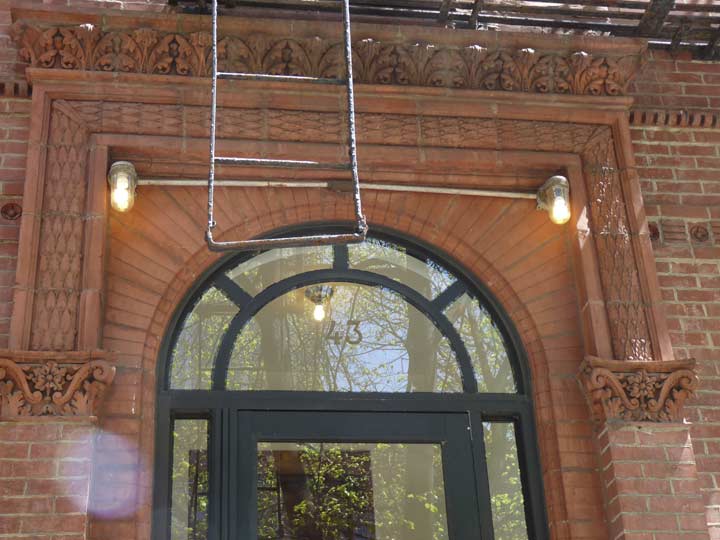 #43 Duffield, in particular, has some excellent stonework designs at its front entrance. The brick half-columns are called pilasters.
#43 Duffield, in particular, has some excellent stonework designs at its front entrance. The brick half-columns are called pilasters.
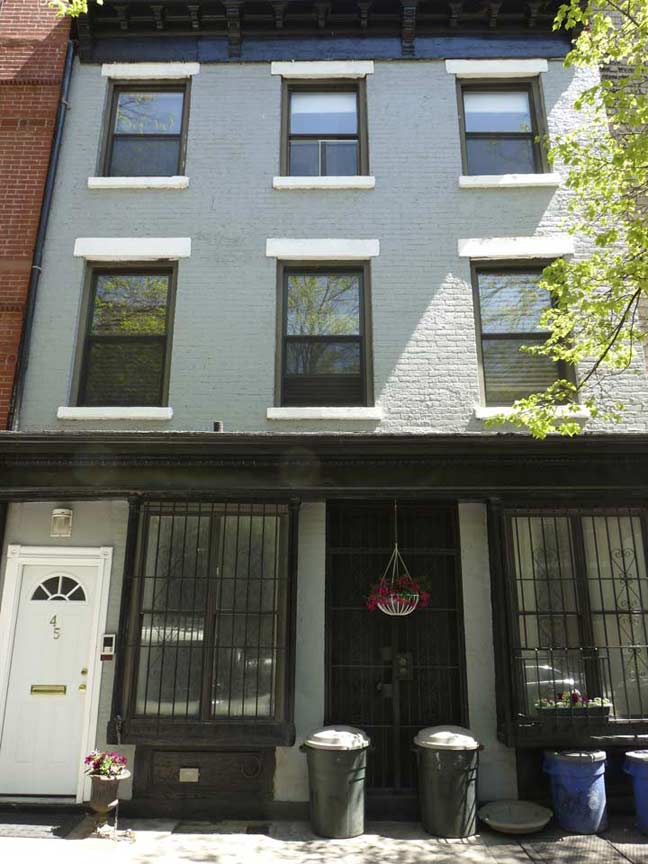 #45 Duffield, a 3 story walkup brick building painted gray and black.
#45 Duffield, a 3 story walkup brick building painted gray and black.
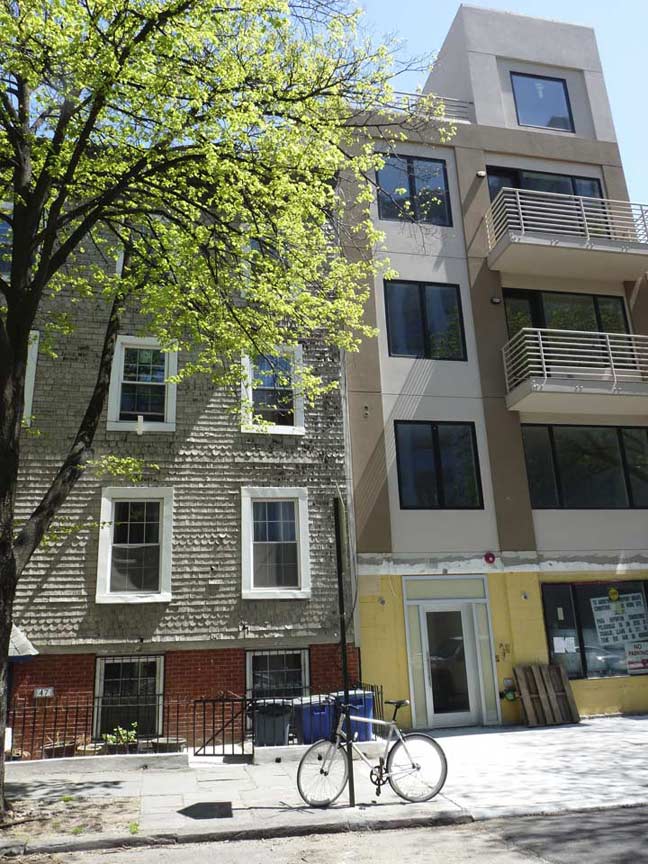 #47 and #49 Duffield. Bridge Plaza isn’t landmarked, so non-contextual buildings have sprung up.
#47 and #49 Duffield. Bridge Plaza isn’t landmarked, so non-contextual buildings have sprung up.
 #51 Duffield is likely the oldest building on the block. The owner, a Forgotten NY fan, was outside and tipped me that it was the subject of an article on Brownstoner by Montrose Morris which says it’s a Federal style house with Greek Revival stylings that likely dates to the 1840s. Note the smaller windows and shutters on the third floor. There was an outbreak of smallpox in the building in 1902 but we assume that, by now, things are pretty safe.
#51 Duffield is likely the oldest building on the block. The owner, a Forgotten NY fan, was outside and tipped me that it was the subject of an article on Brownstoner by Montrose Morris which says it’s a Federal style house with Greek Revival stylings that likely dates to the 1840s. Note the smaller windows and shutters on the third floor. There was an outbreak of smallpox in the building in 1902 but we assume that, by now, things are pretty safe.
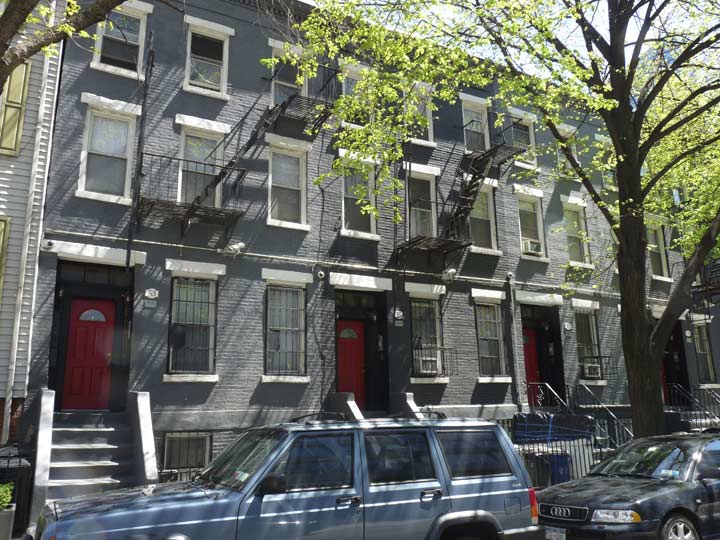 #53 through #59 Duffield, a stellar (at least from the outside) grouping painted gray and white with brilliant red doors with lunette windows.
#61 and #63 Duffield, brick walkup buildings. #63 has what appears to be an original doorway.
#53 through #59 Duffield, a stellar (at least from the outside) grouping painted gray and white with brilliant red doors with lunette windows.
#61 and #63 Duffield, brick walkup buildings. #63 has what appears to be an original doorway.
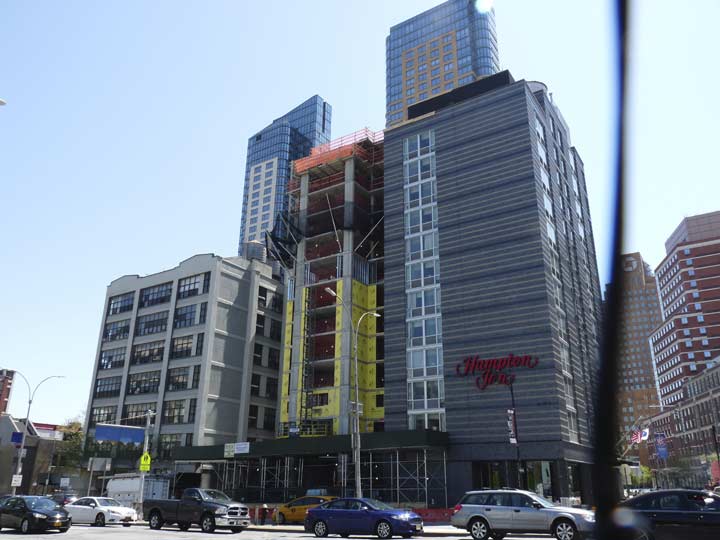 Meanwhile here’s a look at what’s otherwise taking over the neighborhood at Tillary and Duffield: a massive Hampton Inn.
Meanwhile here’s a look at what’s otherwise taking over the neighborhood at Tillary and Duffield: a massive Hampton Inn.
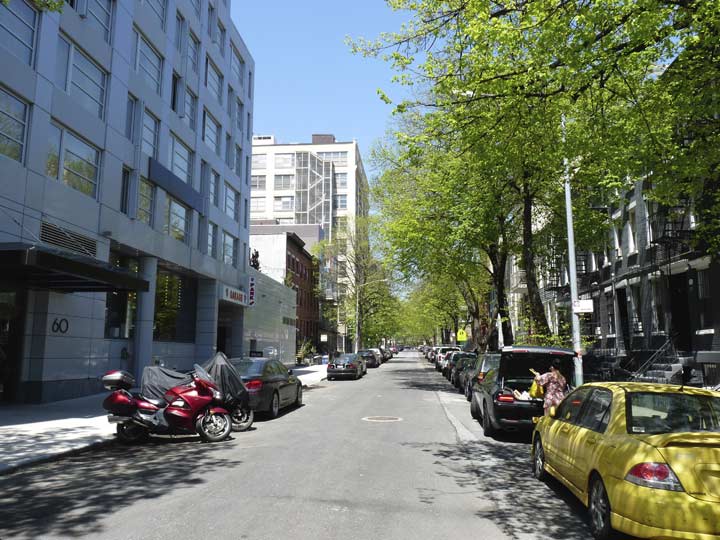 Duffield Street looking north from Tillary. 60 Duffield is a large new hotel with condo units on the upper floors.
Duffield Street looking north from Tillary. 60 Duffield is a large new hotel with condo units on the upper floors.
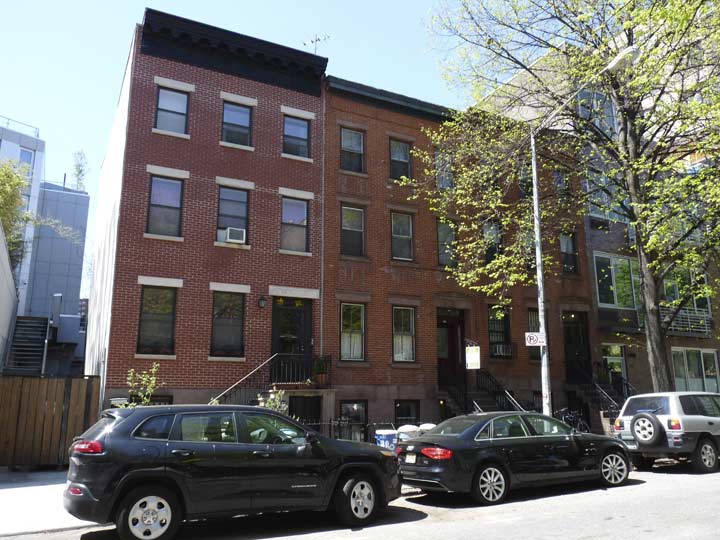 A trio more older Duffield Street buildings on the west side of the street from #46 through #50.
A trio more older Duffield Street buildings on the west side of the street from #46 through #50.
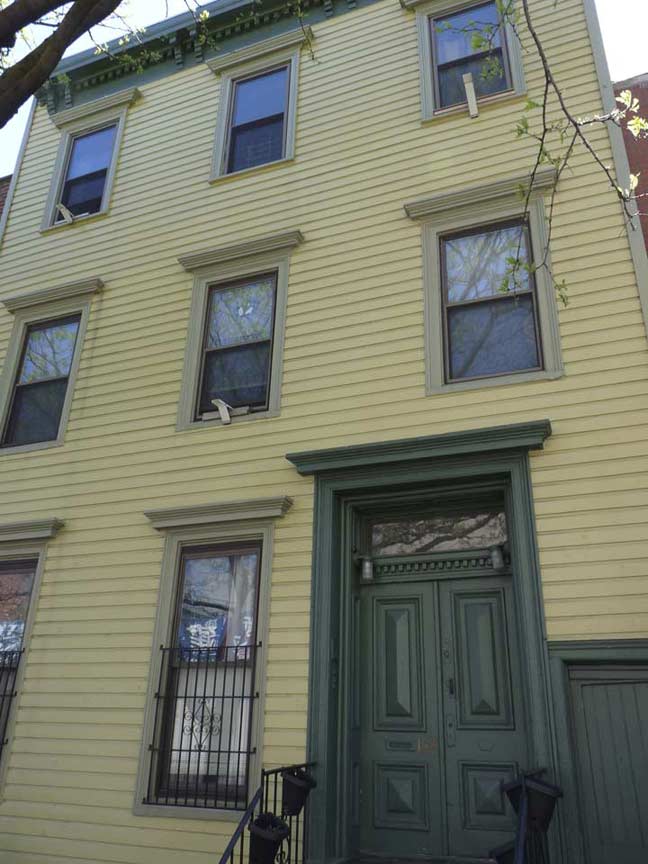 Returning to Concord Street here’s another wood frame building at #184 between Duffield and Gold Streets.
Returning to Concord Street here’s another wood frame building at #184 between Duffield and Gold Streets.
 DUMBO begins at York Street, about 3 blocks north, but by now it’s well-known and you can’t blame these wholesalers for adopting the name on the north side of Concord.
DUMBO begins at York Street, about 3 blocks north, but by now it’s well-known and you can’t blame these wholesalers for adopting the name on the north side of Concord.
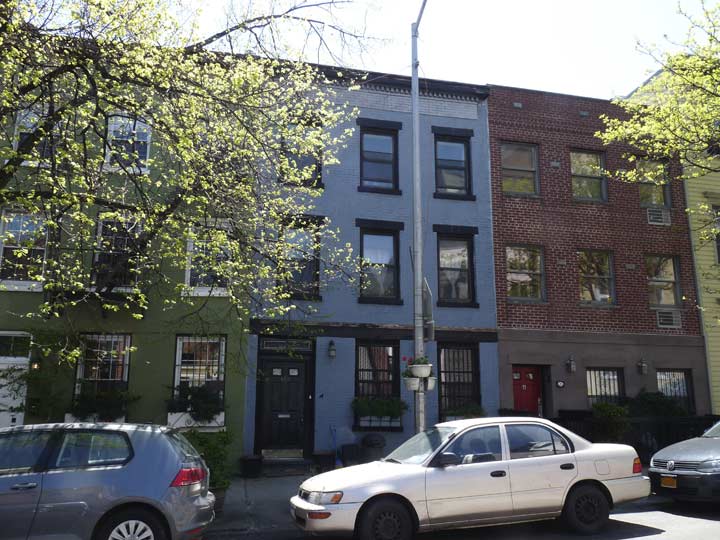 Some original brick Bridge Plaza buildings on the south side of Concord.
Some original brick Bridge Plaza buildings on the south side of Concord.
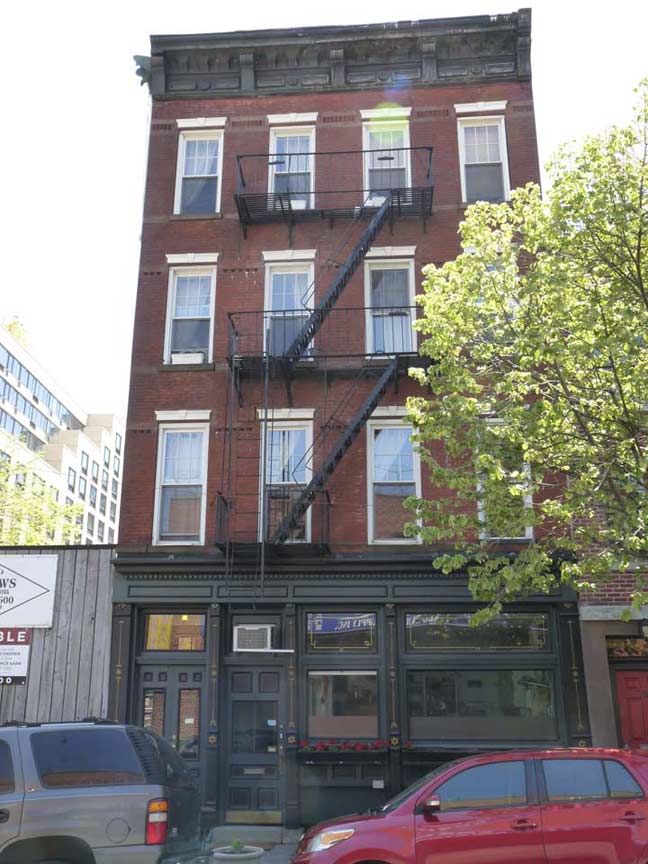 The front of this building just west of Gold Street looks as if it’s been refurbished lately, but in line with what it likely has looked like over the years.
The front of this building just west of Gold Street looks as if it’s been refurbished lately, but in line with what it likely has looked like over the years.
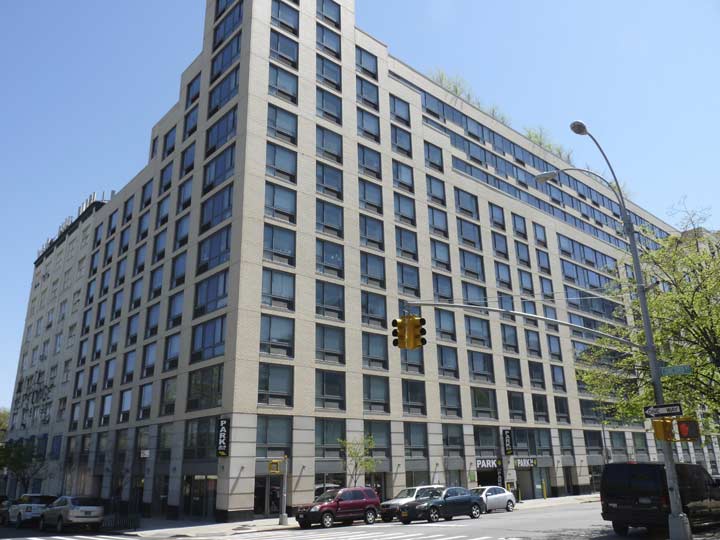 #257 Gold Street, known as BKLYN Gold, at Concord, another huge area condo complex, opened in 2009.
#257 Gold Street, known as BKLYN Gold, at Concord, another huge area condo complex, opened in 2009.
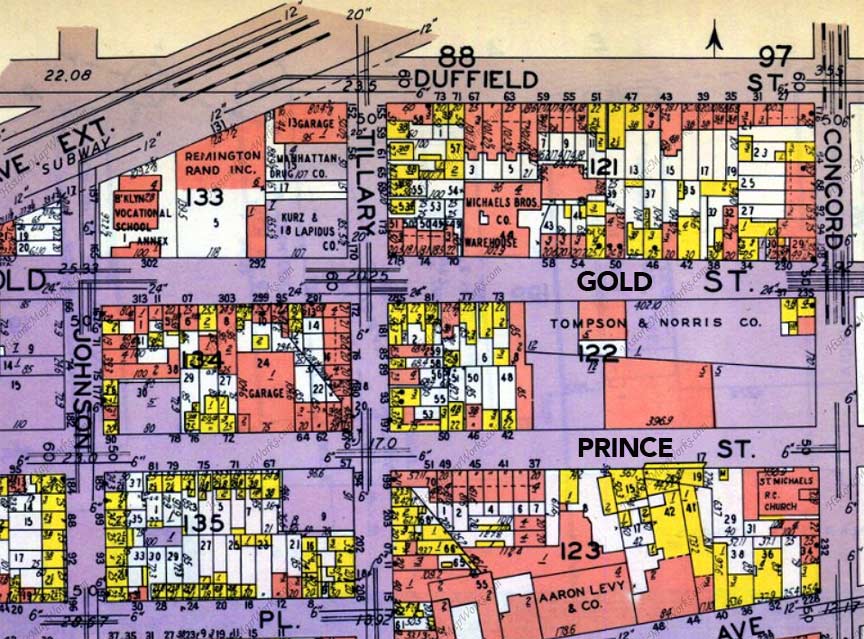 Here’s a Belcher-Hyde atlas plate of the region south of Concord Street between Duffield Street and Hudson Avenue (a street subsequently eliminated by the Brooklyn-Queens Expressway and Raymond Ingersoll Houses). Other than the Thompson & Norris (box) Company (which looks like its eventual replacement, BKLYN Gold) the region was dominated by brick buildings, shown in brick coloring, and wood frames, shown in yellow.
Among other items on the map, Remington Rand made typewriters, Aaron Levy was a butcher and slaughterhouse, and Kurz & Lapidus made shoes.
Here’s a Belcher-Hyde atlas plate of the region south of Concord Street between Duffield Street and Hudson Avenue (a street subsequently eliminated by the Brooklyn-Queens Expressway and Raymond Ingersoll Houses). Other than the Thompson & Norris (box) Company (which looks like its eventual replacement, BKLYN Gold) the region was dominated by brick buildings, shown in brick coloring, and wood frames, shown in yellow.
Among other items on the map, Remington Rand made typewriters, Aaron Levy was a butcher and slaughterhouse, and Kurz & Lapidus made shoes.
 Gorcondia Playground at Gold and Concord (get it?) is under renovation but what’s so dangerous about it is unknown.
Gorcondia Playground at Gold and Concord (get it?) is under renovation but what’s so dangerous about it is unknown.
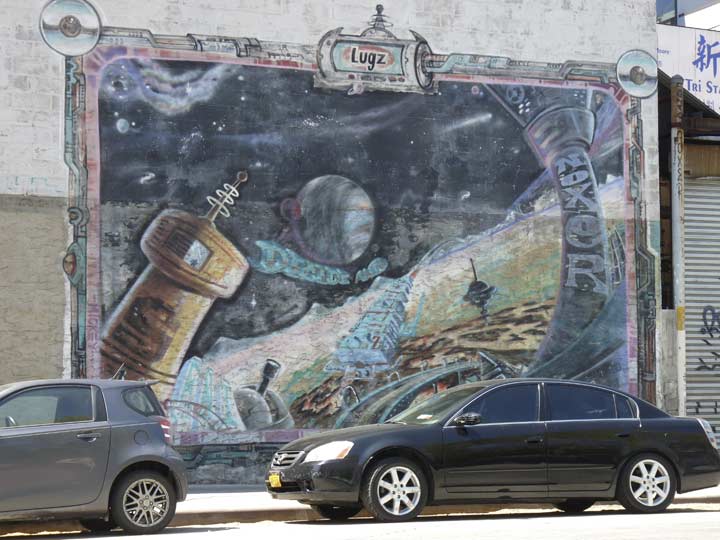 This mural on Gold near Concord has been here for over a decade.
The Brooklyn-Queens Expressway, here crossing Concord, did much to uproot the stability of the neighborhood when it arrived in the 1950s, as well as various housing projects such as the Raymond Ingersoll and Farragut Houses. St. Michael’s Church used to be at the SW corner of Concord and Prince, now occupied by the BQE.
This mural on Gold near Concord has been here for over a decade.
The Brooklyn-Queens Expressway, here crossing Concord, did much to uproot the stability of the neighborhood when it arrived in the 1950s, as well as various housing projects such as the Raymond Ingersoll and Farragut Houses. St. Michael’s Church used to be at the SW corner of Concord and Prince, now occupied by the BQE.
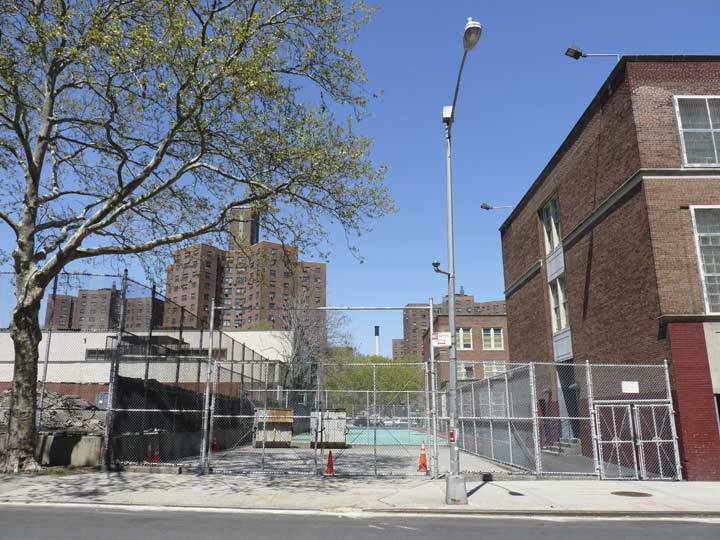
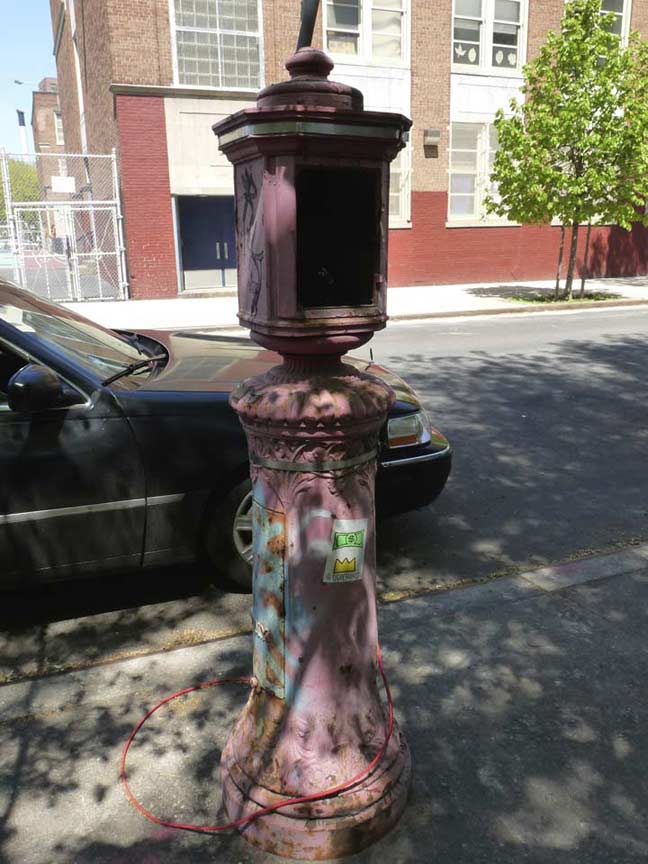 This midblock space between the playground and PS 14, as well as a midblock fire alarm, marks the spot where a vanished street, Nassau Place, once went through. There were dozens in the area: see them on the Downtown Brooklyn Street Necrology page.
PS 14, now PS 287, the Dr. Bailey Kelleigh Ashford School, marks the end of Concord Street at Navy Street. Ashford (1873-1934) was a US Army Colonel who developed treatments for anemia and hookworm in Puerto Rico, and there founded The School of Tropical Medicine.
4/30/16
This midblock space between the playground and PS 14, as well as a midblock fire alarm, marks the spot where a vanished street, Nassau Place, once went through. There were dozens in the area: see them on the Downtown Brooklyn Street Necrology page.
PS 14, now PS 287, the Dr. Bailey Kelleigh Ashford School, marks the end of Concord Street at Navy Street. Ashford (1873-1934) was a US Army Colonel who developed treatments for anemia and hookworm in Puerto Rico, and there founded The School of Tropical Medicine.
4/30/16

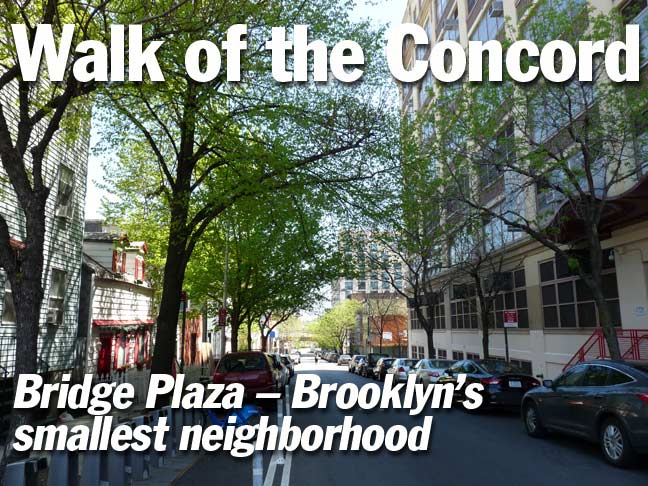
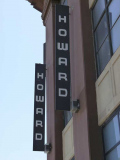
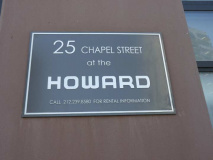
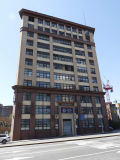
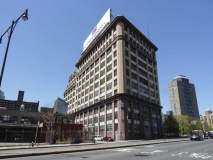
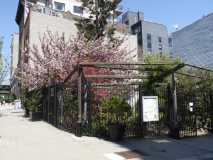
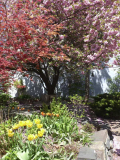
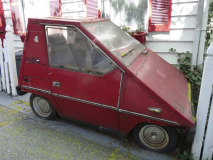
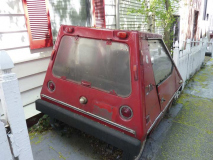
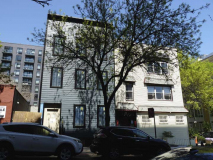
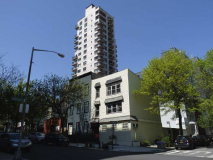
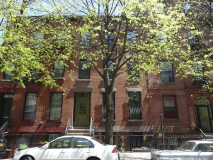
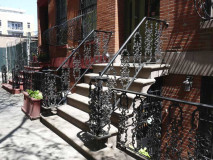
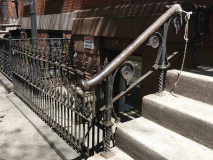
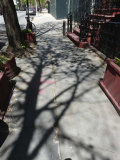
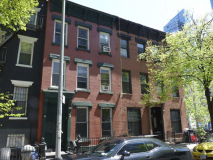
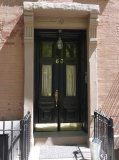
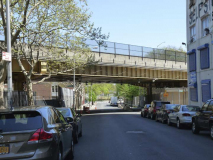
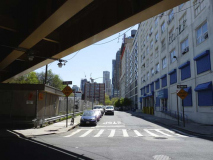
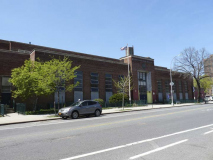
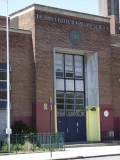
5 comments
My dad worked in the Howard Clothes Fsctory. Found a pic with part of the sign on FB . Looking for a better pic
The “Howard Building” is one of my favorite things- it is at 40 Flatbush Extension and was the Sperry Gyroscope Building until 1944.
It may be somewhat forgotten, but I like to use it to get my bearings.
As a child I lived on Concord St in the mid 1960s in a house across the street from what is now a high school. I have fond memories of Concord St because it seemed far removed from the hustle and bustle of the rest of Brooklyn. I believe the house is gone, perhaps part of the garden now.
I was just looking for additional pics of Howard Clothes stores and came across this because I recently posted a 1972 pic I took of the Howard Clothes sign on the History of Brooklyn Facebook page.
Thank you for this. I recently came across a baptism certificate from my family’s dating back to 1928 at St Michael’s. All in Italian. I couldn’t find it anywhere. So I looked up prince and concord, which sounded familiar, and was landed here to this page. Unfortunate that it is no longer there but at least I got to see where it used to be thanks to you.